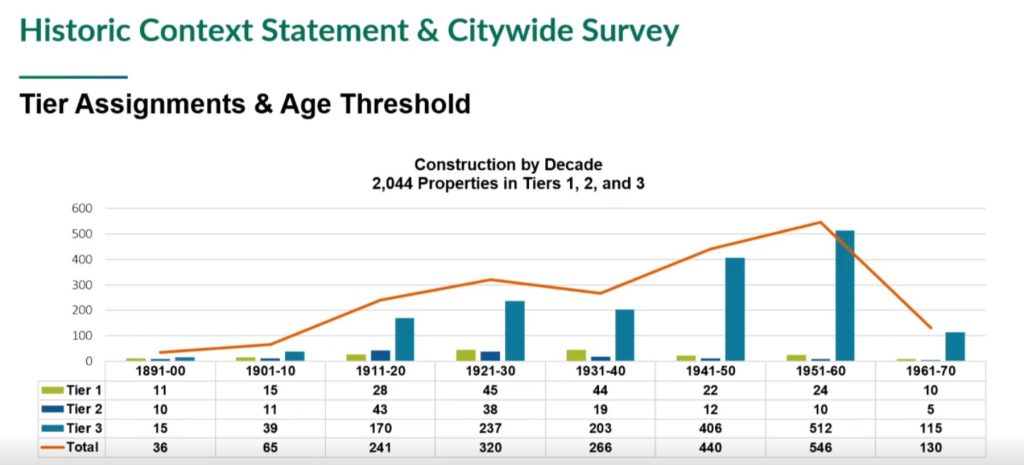
After more than two decades reviewing potentially historical homes individually, Coronado may instead use a citywide survey to exclude some homes from the review process.
It’s an effort to streamline a bulky and expensive historical review process, although critics question the survey’s accuracy. The survey considered 2,044 homes 75 years old or greater and determined that 1,698 of them were ineligible for historical designation.
It’s a contentious move, so the Coronado City Council at its Nov. 21 meeting voted to send notices to residents about the results of the survey and to solicit input about the potentially excluded properties.
Once notified, the public will have 60 days to comment.
Councilmember Mike Donovan, who sat on a subcommittee with Councilmember Carrie Downey to develop the city’s draft historic context statement and survey, said the survey was meant to optimize the arduous process the city has been grappling with since it implemented its historic ordinance two decades ago.
“Before 2000, there was no historic ordinance and people were tearing houses down left and right,” Donovan said. “The survey was meant to streamline the process so that we’re not taking every single home that is a certain age through the evaluation process, because that would become unsustainable. It would be too much money and too many resources.”
Current city code mandates that a historic research report be prepared for any property older than 75 years requesting a project that requires demolition or removal of architectural features that are visible from the street.
These reports cost the city an average of $7,000 each. Since 2019, the city has prepared 122 historic research reports, at a cost of $863,766.
As an alternate method, the citywide survey considered properties built before 1970 that have not yet come under historical review and divided them into tiers based on their architectural significance:
Tier one: Unaltered or minimally altered properties that may be eligible for city designation; 199 properties fell into this category.
Tier two: Properties recognizable as a particular architectural style that have been altered enough that they do not appear eligible for historical designation; 148 properties fell into this category.
Tier three: Substantially altered properties that are not eligible for historical designation; 1,697 properties fell into this category.
Most of the 2,044 properties considered in the survey fell into Tier 3 – which would exclude them from the historical review process. While councilmembers agreed that the process of historic review was too bulky, they worried about excluding so many properties from consideration.
Councilmember John Duncan suggested that the city notify not only the owners of properties surveyed, but also, all residents, of the tier three properties and potential exclusion from historical status, and to implement a 60-day comment period on whether any Tier 3 properties should be moved to Tiers 1 or 2.
The council voted 4-1 to do so, with Councilmember Casey Tanaka voting in dissent.
“I would rather keep the system we have in place because we’ll have fewer mistakes in terms of historic homes being taken down,” Tanaka said. “If we over rely on the historic context survey, then I think we’ll have some homes receive demolition permits that shouldn’t have.”
The push for a historic context statement
A historic context statement is a document that outlines how a municipality organizes its properties. Adopting one would clarify to homeowners and potential buyers whether their home might be designated historical (which carries financial implications) and aims to reduce administrative costs the city incurs when it reviews each property individually.
Historical designations are decided by the city’s Historic Resources Commission, and to be deemed historically significant, a property must meet at least two of four criteria. The citywide survey only considered Criterion C, which assesses whether a structure possesses distinctive characteristics of an architectural style, and has not been substantially altered.
The other four criteria require in-depth analysis inappropriate for a survey. However, only seven of the 230 properties that the HRC have designated historical did not meet Criterion C, said Tricia Olsen, a senior planner for the city.
The city has been developing its draft historic context statement since 2019, and Downey said she’s been trying to implement a historic context statement for more than 20 years.
“I didn’t think the rules were understandable,” Downey said. “That is why I’ve been pushing for a survey, because property owners just want to know. Real estate agents that are going to sell just want to know. Buyers just want to know: Is this property historic?”
Property rights
The debate over historically designated properties hinges on the interplay between preserving Coronado’s historical character, property rights, and government spending. In August, city council spent significant time debating that interplay in the context of a single property on Alameda Boulevard.
Property owners whose homes are designated historical must follow an arduous process when making changes to their properties – and owning a historically significant home means wide-scale modifications or tear-downs are prohibited.
However, historical properties that are being preserved are eligible for a break in property taxes under the Mills Act. Like most elements of the tax code, it’s difficult to discern just how big a tax break that entails.
“Typically, property owners can expect a 20% to 70% savings on their property taxes,” a document from the San Diego County Assessor’s Office reads – a wide pendulum for tax planning.
During public comment at the Nov. 21 Coronado City Council meeting, one homeowner decried his inability to demolish and redevelop his property due to its age. But others argued the unique, architecturally rich properties on Coronado are part of what gives the city its charm – and draws tourism dollars.
Coronado Mayor Richard Bailey suggested a voluntary historical designation program, and cautioned that having too many officially designated homes would cause a financial burden to the city in lost property taxes and administrative upkeep.
“Philosophically, I have a problem with any process that includes an involuntary designation,” Bailey said.
Bailey suggested using some of the money saved from the historic review process to further incentivize historical designation, theoretically giving property owners more choice while still maintaining historical value. He also suggested capping how many properties could carry historical designation.
“I think we as a city have to be somewhat sensitive to the fact that there are significant financial implications here,” Bailey said. “What percentage of our home stock in the village is a reasonable amount to aspire to? We’re already at 2.5 percent.”
Council considers lowering historical age threshold to 50 years
Coronado experienced a boom in construction in the 1940s through 1960s. Currently, the city reviews properties that are 75 years of age or older, but the council considered reducing that threshold to 50 years, which aligns with state standards.
“Should the city council change the age threshold to 50 years, 763 additional properties built through 1970 would require historic review,” Olsen said.

Councilors ultimately opted against changing the age threshold to 50 years, noting that, as time passes and the 50-to-74-year-old properties continue to age, they will eventually come under review.
Vickie Stone, curator of collections for the Coronado Historical Association, spoke at the meeting in support of changing the threshold to 50 years and urged the council to consider designating a historic district within the city.
“CHA has expressed a deep concern regarding the accuracy of the historic research survey,” Stone said, “and possibly the utilization of the survey as the basis for removing homes from the city’s current process.”
Other public commenters expressed similar concern that eliminating so many homes from consideration might cause historically significant homes to be modified, while some said it was unfair that properties owners had to undergo such palaver to modify their own homes.
Council will reconsider the matter once residents are notified and the 60-day comment period has passed.
Related:




